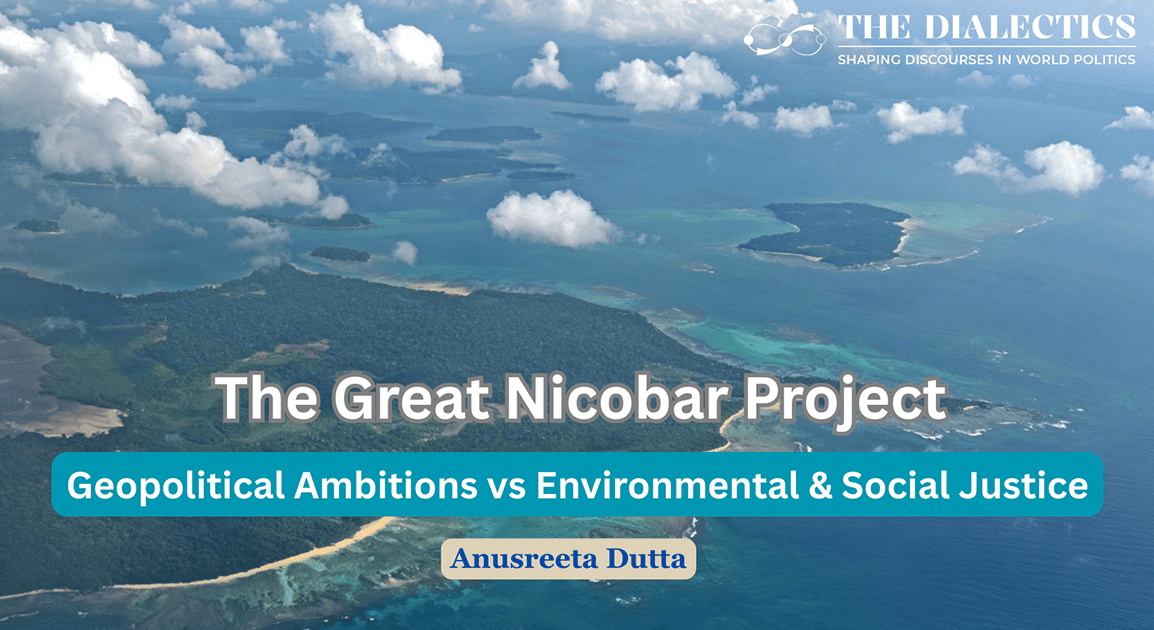The Great Nicobar Project of India represents a critical juncture in the country’s geopolitical and economic strategy, exposing the contradictions of development in the postcolonial state. Approved by the Indian government in 2021 with an initial budget of Rs 72000 crore, the project encapsulates India’s ambition to cement its strategic position in the Indo-Pacific. After evaluating the project’s scope and phases, the budget was revised to Rs 8000 crore. Over three decades, this multisectoral development aims to build a township accommodating tens of thousands of people, an international airport, power plants, and a deep-sea transshipment port.
The initiative intends to position India at a pivotal point where urgent issues about environmental preservation and the rights of indigenous groups that have long thrived in these forests for centuries collide with strategic aspirations and goals for economic progress. With the intention of placing India at the forefront of global marine trade and economic development, the government presents this proposal as a bold move.
However, these strategic aspirations run the risk of overshadowing pressing concerns about environmental preservation and the rights of indigenous populations, who have co-existed peacefully for ages. While concealing the disproportionate ecological and social costs borne by local populations and ecosystems, the state’s national security narrative glosses over the unequal distribution of benefits.
Though official statements underscore that this development will stimulate both regional and national growth by enhancing infrastructure, connectivity, and employment opportunities. Yet the narrative remains one-sided, focusing almost exclusively on the promises of economic progress while downplaying the environmental and social trade-offs involved.
Geopolitical Calculations Masked as Economic Progress
The Great Nicobar Project cannot be overstated. The project is an important part of India’s aspirations to increase its marine footprint in the Indo-Pacific, and it is situated near the Malacca Strait, one of the busiest maritime corridors in the world. At this moment, a large portion of India’s container shipping is handled by foreign ports like Srilanka, Singapore, and Malaysia.
The planned deep-sea port holds the promise to shift the balance, cutting costs and boosting India’s capability to control crucial shipping lanes. The port is also intended as a strategic naval hub, balancing growing Chinese influence in the region and securing India’s maritime interests. This dual role reflects India’s growing anxiety about China’s expanding influence in the Indo-Pacific to assert itself as a regional power.
The narrative spun by the Indian Government frames the project as a catalyst for national economic growth, promising thousands of jobs and an infusion of business activity in a region historically left marginalized. Eco-tourism, which makes use of the island’s natural beauty, has the potential and is recommended as a path to revenue generation. Further, the project has the potential to position India to dominate the global supply chain with the ambition for $5 trillion economy.
The accompanying airport is meant to serve commercial and defence purposes, further emphasizing the location’s regional importance. The project is argued to generate thousands of jobs and stimulate regional and national business. This further emphasized the location’s strategic value, offering India the ability to project power and facilitate civilian connectivity in a region of immense military and economic importance.
The Grim Environmental Trade-off
Any ambitious development comes with a price. The Great Nicobar Project is anticipated to clear over 130 square kilometres of primary rainforest. These rainforests are home to unique plants, animals, and endangered species like the leatherback sea turtle. The Galathea Bay Wildlife Sanctuary was denotified as a result of the project. Conservationists have expressed concerns about the long-term harm this project can cause to marine and forest ecosystems. Further, the island’s position on seismic fault lines adds a layer of complexity. The vulnerability of the region to earthquakes and tsunamis is not hypothetical. The pain of the 2004 Indian Ocean tsunami, which devastated the region, is still vivid in people’s minds and acts as a sobering reminder of danger and vulnerability.
Despite this, the government’s Environmental Impact Assessment has been widely criticized for its lack of thorough, site-specific studies. Scientists and independent experts have repeatedly called for more rigorous, transparent assessments to adequately prepare for risks, while their concerns remained unheard.
The project’s effect on the Shompen and Nicobarese tribes is its most important component. The island, forests, and rivers are vital to these people’s survival, and they live in harmony with nature and traditions. Because of these developments, they are vulnerable to cultural fragmentation, disruption of their ancestral lands, and exposure to changes for which they may not be prepared.

Despite the government’s dedication to upholding and safeguarding indigenous rights, there is reason to be skeptical. Previous attempts in India have often failed to provide sufficient protection, putting vulnerable people in danger. Through the Nicobar project, India’s aspirations are embodied to grow economically at its strategic frontiers. But it is also meant to test the nation’s commitment to environmental stewardship and social justice.
Towards an Alternative Path
The ambitious Great Nicobar Project of India is not merely an infrastructural initiative aimed at strategic expansion and economic growth. It is a test of the nation’s dedication to social justice, environmental stewardship, and postcolonial governance. Striking a balance between competing demands-indigenous rights, economic ambitions, environmental preservation, and strategic necessity is challenging.
If India carefully handles these challenges, the project could reflect how a significant strategic undertaking blends sustainability and social justice. It might act as a model for developing sensitive regions without sacrificing their ecological and cultural resources.
If this isn’t done, India’s reputation as a rising nation that prioritizes accountability over carelessness could suffer irreparable harm. India’s ideals will be reflected in the Great Nicobar’s future rather than its ambitions. The path from idea to reality will require bravery, teamwork, and consideration for both people and the environment.
Lastly, a top-down planning will be insufficient to get from vision to implementation. It necessitates strong political will, sincere community involvement, open decision-making, and a strict commitment to social and ecological justice.





